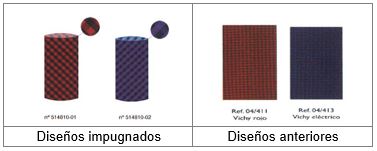Simply applying the typical pattern of a “cachirulo” (traditional Aragonese bandana) on a different item of clothing does not confer individual character on the design
Albeit still toned down due to the restrictions of the pandemic, the recent celebration of the festival of the Virgin of Pilar has given the inhabitants of Zaragoza the chance to wear the cachirulo, a characteristic bandana typically in a red and black check print.
This item of clothing, which was originally worn by farmers in the region and is currently a symbol of Aragonese folklore, has been reviewed in the Judgment 608/2021 of September 16, 2021, in which the Supreme Court declared invalid two industrial designs consisting of the typical cachirulo pattern on a neck warmer:

Original Buff S.A. filed an invalidity claim pursuant to Article 65 of Law 20/2003 on Legal Protection of Industrial Designs (LDI) in relation to Articles 13 and 7 LDI regarding individual character, on the grounds that the registered designs produced the same overall impression as the one produced by the typical Aragonese bandana and that the same product had already been used in trade by the claimant.
The owner of the contested designs argued that the novelty of its designs lay in applying a traditional pattern to a specific shape, in this case an elastic neck warmer, which gave the design its overall novelty.
The claim was dismissed both at first and second instance on the grounds that the tubular shape generated a new combination of colors, shape and texture and that certain features of the claimant’s pattern were different to that of the new designs, since the latter did not need to be tied. In other words, the courts considered that applying a check pattern to an item of clothing with a shape or form of use that was different to the one that already existed, gave a different overall impression.
The claimant filed a cassation appeal questioning the application of the case law criterion that establishes that the assessment of the overall impression of a design must be made bearing in mind the way in which the product represented by that design is used. That is to say, the appellant questioned whether the comparison had to be made between the designs themselves or between the products in which they were incorporated.
The Supreme Court has now upheld the cassation appeal, holding that merely applying a pattern that has already been disclosed, such as that of the cachirulo, to a different item of clothing does not in itself give the design individual character if it does not produce a different overall impression on the informed user.
The Supreme Court recognizes that Article 7.1 of the LDI does not make the novelty and individual character of a design conditional on the products in which it will be incorporated. It could be said that this decision rules out the possibility of applying some sort of principle of specialty, typical of trademark registrations, on designs, which would limit protection to a particular sector.
In support of its arguments, the Supreme Court expressly mentioned the Judgment of the Court of Justice of the European Union of September 21, 2017 (C- 361/15 and C-405/15P, Easy Sanitary Solutions v Group Nivelles/EUIPO), in which the CJEU confirmed that the indication of the product used in the design registration does not limit the scope of protection, because, to use its own words, allowing the holder of a subsequent registration, obtained despite the earlier disclosure of an identical design intended to be incorporated in a different product, to prohibit the use of that same design even for the product that was the subject of the earlier disclosure, would be an “absurd result”.
In short, the outcome of the case confirms that the registration of a design does not protect the idea of applying a design (in this case a check pattern) already disclosed to a different item of clothing, but rather the design itself, as an expression of the formal innovation of the appearance of a product or its ornamentation.
Garrigues Intellectual Property Department






